Diamonds and Ferrari’s. Goods and brands that cannot seem to charge enough to lower demand.
I was taught the law of demand when I went took economics at Carleton University. If something can be made cheaper, then people will buy more of it. If the price is raised, then people buy less.
But some brands seemed to defy this law routinely. These brands seem to be able to charge whatever they want, and they end up selling the same amount or more.
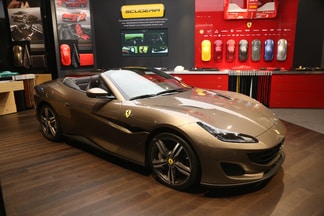
For example, Ferarri’s CEO, Sergio Marchionne, announced in May 2018 that they presold all the cars they expected to make for the next year and a half. Apple set the price of the original iPhone at $499 – $599; now, the iPhone Pro sells for $999 – $1099 and still had line ups in front of stores on its launch day.
Many people work hard to build a brand for their business in order to charge a premium. Why are some brands able to charge more? And how do we build a premium brand?
The answer is because the products of the brand become Veblen Goods.
A Veblen Good is a luxury product, such as diamond jewelry or supercars, where the quantity demanded by the market increases as the price increases. This relationship is the opposite of most goods.
In this article, we learn about Veblen goods. We learn some examples, and how they work. We learn how they are different from Giffen goods and goods with inelastic demand. We also learn about how conspicuous consumption means people buy things to display their wealth.
Brands are a modern way for someone to display their wealth, so we introduce the concept of Veblen brands. We go into what Veblen brands are and through some examples. I go deep into the Supreme brand, and pull out some lessons about how all brand builders can make a Veblen brands.
Veblen Good
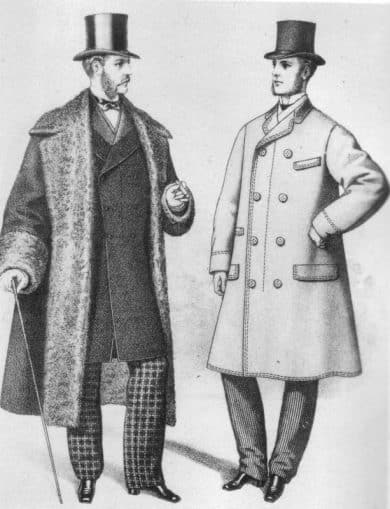
One theory is that the products from certain prestige brands become Veblen goods. The term is named after Thorstein Veblen, an American economist detailed conspicuous consumption in his book The Theory of the Leisure Class in 1899. He theorized wealthy individuals purchased some luxury goods because of, not in spite of, their high price because they wanted to show off their status and excess.
Products such as sports cars, jewelry, or designer dresses become more useful as status symbols the higher they are priced. A Lamborghini more effectively signals it’s owner’s status when it is the expensive model.
For most things, the price has no bearing on the utility value. The same shovel digs holes just as well whether it was purchased at full price or discounted.
This unique tie between price and value created a novel economic condition. A Veblen good is not governed by the economic law of demand, which states: people demand less of something when it grows more expensive. When the price of a Veblen good goes up, it becomes more desirable, and the market demands more of it. As Thorstein Veblen observed: the high price is a feature, not a bug.
For example, if you see the brand pasta you normally buy in a display bin on sale for $1, then you may load up your pantry with that pasta. If you see a container of products labeled “luxury watches” on sale for $29.95 each, then you probably would walk right by. You aren’t loading up your top dresser drawer with cheap watches. The pasta is a common good, and genuine luxury watches is a Veblen good.
Veblen good
The more expensive they are, the more customers want them.
The lower a Veblen goods price, the less people will demand it.
Normal good
The more expensive they are, the less customers want them.
The lower a normal goods price, the more people will demand it.
| ↓ Lower Price | ↑ Higher Price | |
| Normal Good | ↑ Higher Quantity | ↓ Lower Quantity |
| Veblen Good | ↓ Lower Quantity | ↑ Higher Quantity |

What are examples of Veblen goods?
Goods that people use to show off wealth like diamonds and fine art.
Veblen goods are always luxury goods, meaning things that people spend proportionally more on as their income increases. Veblen goods are never necessary goods.
Usually, but not always, Veblen goods are highly visible displays of wealth such as jewelry in rap videos, or mansions on the coast of a city.
Examples of Veblen Goods.
- Diamond Jewelry
- Designer Purses and Bags
- Designer Dresses
- Swiss Watches
- Exotic Cars
- Artwork
- Fine China (Dishware)
- Lawyers
- Chief Operating Officers
High Priced Lawyers
I know it is unpleasant, but imagine your business is being sued for patent infringement. You are introduced to two lawyers who graduated from the same law school and have similar amounts of working experience.
The first lawyer charges $320 an hourly rate and requires a $10,000 initial retainer for infringement cases. He or she only works with large corporations that can afford those terms.
The second lawyer says: “I will only charge as much as you can afford, and don’t worry about a retainer.” He or she works exclusively with small businesses and start-ups.
Who would you assume is the better lawyer to defend you?
Note: this example gave no information about the skill and knowledge of either of the lawyers. Either one could be good or bad at defending you in court.
But most people would assume the high priced lawyer is better than the flexible lawyer. Most people will choose the high-priced lawyer even though it is against their financial interests.
Giffen Good vs. Veblen Good
Demand goes up with an increase in price for both, but a Giffen good has more to do with poverty than luxury.
A Giffen good is another type of product that increases in demand as price goes up, much like a Veblen Good.
But unlike a Veblen Good, a Giffen good is a necessity. The increase in demand has to do with poverty. Giffen goods are always inferior goods meaning people would prefer to have their needs met with higher-priced items.
If an impoverished group of people has to deal with a price increase on an essential item, the increased cost crowds out room in the budget for higher-priced goods that do the same thing.
For example, imagine a low-income family gets 60% of their calorie needs filled by grains and the other 40% by meat. Now the price of grains goes up. They may have to have 80% of their calories needs filled by grains because they can now afford less meat.
So when you are talking about Giffen goods, you are talking about necessities like rice, grain flour, and kerosene. Those are far different than the diamonds and supercars typical of Veblen goods.
Good with Inelastic Demand vs. Veblen Good
Sometimes it looks like demand is increasing with price, but demand is just insensitive to price.
Many products can increase in price and not experience much of a drop in price. If you increase the cost of gas, then the amount of gasoline sold in the market overall does not change much; people may reduce their travel a little, but they still need to fill their gas tank get to work and get groceries.
But these are not Veblen goods because if the price goes up, then the quantity demanded goes down even if slightly. If they were a real Veblen good, then the amount would go up.
Inelastic demand is a term economists use to describe goods where quantity goes down only slightly to significant increases in price. Products like textbooks, business travel, and surgeries have inelastic demand; all great industries to establish a business in, but not Veblen goods.
Conspicuous Consumption

When people buy something to show off that they can afford it.
To understand Veblen goods, you have to understand conspicuous consumption. It is what Thorstein Veblen was studying when he discovered Veblen goods in 1989.
Conspicuous consumption is purchasing as a social signal to display wealth. A product that is conspicuously consumed is not bought for its utility value; someone is buying it to show the people around them that they are wealthy.
For example, a person may buy a Honda Civic to get from A to B. An affluent person may choose to purchase a Bentley Continental so they can look rich as they are driving from A to B. The Honda is available to the person that brought the Bently if the car was all about the utility, but they also value the social signals they are sending to their peers, neighbors, coworkers, and competitors.
Examples of goods that are purchased to show off wealth and status are engagement rings, luxury vehicles, furs, private jets, five-star restaurants, and certain resorts.
The brands someone chooses to be seen with can also signal their wealth. We call those Veblen brands.
Veblen brand
Brands that cannot seem to charge a high enough price to scare away customers.
Some brands achieve a status where they cannot seem to charge enough to curb demand for their product. We already talked about how Ferrari sells out of cars a year in advance, and Apple charges more for an iPhone then they ever have.
Thorstein Veblen would not have been surprised at this because brands have become essential tools in conspicuous consumption. Where once the leisure class would have to adorn themselves with silk, leathers, and jewelry to show off their wealth, now people can just display the logo of their luxury brands on the chest of their t-shirt or hood of their car. Certain brands are symbols of wealth.
Note that the presence of a logo from a brand with status makes it a completely different good. A white t-shirt is worth $10. But a Louis Vuitton / Supreme boxed logo t-shirt retailed for $485 and then sold for $1750 on the secondary market. A t-shirt is a commodity, but a Supreme t-shirt is a Veblen good. The presence of that red box logo changes the game.
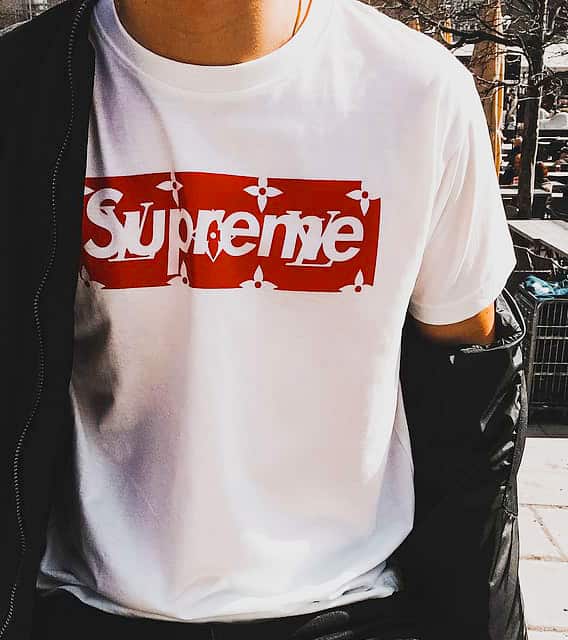
I recently did a podcast with Edward Cervantes about the eighth generation of Chevrolet Corvette. The engineers switched from a front-engine drivetrain layout to a mid-engine layout more common in exotic cars. In doing so, they exceeded the performance of the Ferrari 488.
Edward thought that no one would buy a Ferrari after this, while I said this wouldn’t hurt sales for the Italian brand at all. Nothing Chevrolet could do to the performance of their product could match the cache of the Ferarri brand.
Veblen brands and counterfeit.
These brands are prime targets for counterfeits and have the most to lose with fake products out in the marketplace.
Veblen brands are the brands that are most valuable to counterfeiters. The unit price and pent up demand in the middle class means that criminals can quickly and easily make a buck by selling inferior merchandise with a brand’s logo on it.
But a counterfeit good undermine the brand in profound ways. The fake product introduced to the market may become a substitute for what people were going to buy from the actual brand, but not as much as you think. The people who purchase counterfeit goods were probably never in the market for the genuine product at its full price. They are buying the fake to display it as something they would never be able to afford.
The real cost of counterfeits to Veblen brands is the loss of brand equity. The brand is diluted because the brand ceases to be a status symbol if poorer people are suddenly showing it off everywhere.
For example, Valentino’s Rockstud Shoes are heels with a distinctive design that is known to be expensive. If a large volume of counterfeits are unleashed into the market, then the brand loses that association with wealth that their marketers have worked hard to develop. Therefore, they need to be diligent and aggressive about legally combating counterfeiters, or their brand will be diluted.
Examples of Veblen brands
Brands like Supreme, Bentley, and Louis Vuitton are Veblen brands.
There exist brands that cannot seem to charge too much. These brands are broadly associated with high prices and wealthy people. Both people with money and people who admire people with money agree that the logos of these brands are status symbols.
Examples of Veblen brands are:
- Beats
- Canada Goose
- Cristal Brut
- Bentley Motors
- Rolls Royce
- Lamborghini
- Ferrari
- McLaren
- Fendi
- Apple
- Louis Vuitton
- Gucci
- Christian Louboutin
Have more examples of Veblen brands? Please tell me about them in the comments.
Supreme
An in-depth example of a true Veblen brand.
Supreme is a brand with a simple white wordmark in a red rectangular box. But put that logo on anything, even a brick, and that object instantly becomes a status symbol. But seriously, what are you going to do with a status symbol brick…?
Supreme cannot seem to sell their products at high enough prices to keep them from selling out and going for multiples of the retail price on the secondary market. Their jackets, hoodies, and pants regularly sell for between $100 and $300. And the prices get even crazier on the second-hand market; a Louis Vuitton / Supreme boxed logo t-shirt went for $1,750. Their products are re-sold for three to five times the retail price by brokers.
James Jebbia founded Supreme in 1994. It was initially a brand for skateboarders, like DC Shoes. Their first retail location was on the island of Manhattan in New York City.
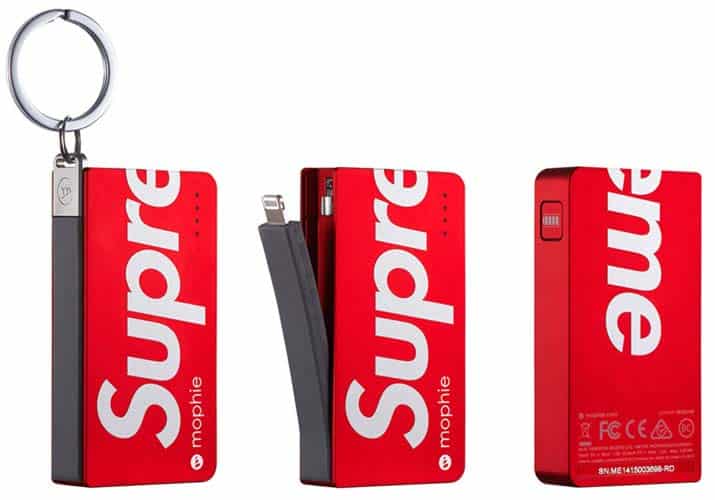
Now they operate eleven retail locations and their online store. Their product has worldwide demand. They have co-branded products with partners like Nike, The North Face, Lacoste, and Louis Vuitton. We profiled one of Supreme’s collaborations with Mophie on a battery pack.
Supreme has seasonal collections that are all new each release. The Supreme stores close for weeks between seasons so they can cycle in the latest merchandise and prepare for the busy period at the beginning of the season. When they reopen, there are lines around the block on all their locations. These lines also deepen Supreme’s appeal because of social norming; all those people in line cannot be wrong, so maybe I should look into Supreme.
When most apparel companies have a successful garment, they run back to their suppliers to make more. Not Supreme. The exclusivity that comes from the limited runs of products is something their clients’ value; all of their products are limited editions in a sense, so you are unlikely to see your squash buddy rocking the same Supreme tee as you after a game.
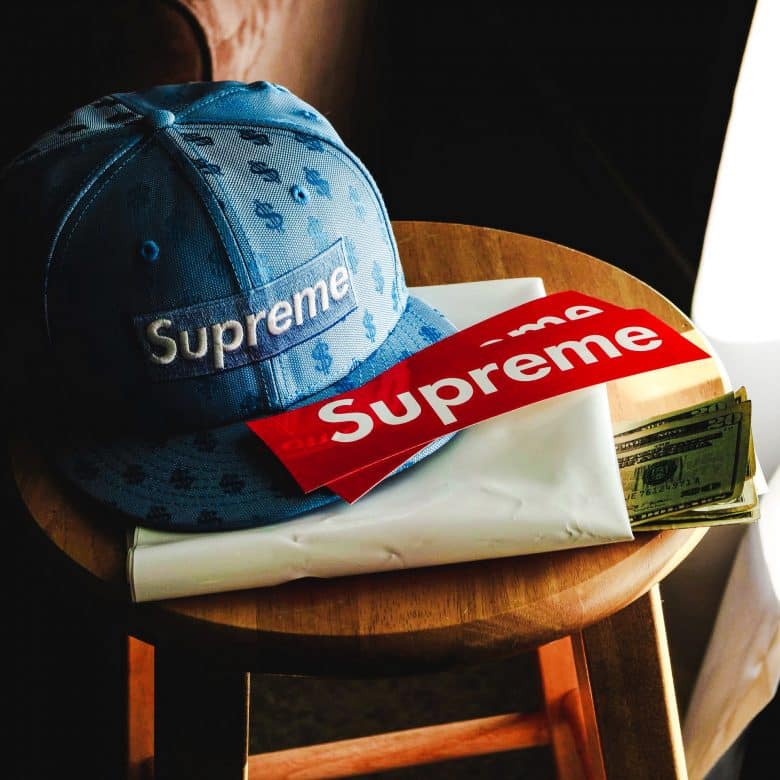
The limited amount of supply online has created a cottage industry of people and bots who will sit and click “buy” on the Supreme website for other customers or brokers.
The Carlyle Group made a significant investment in Supreme, so it remains to be seen if the outside equity pressures them into making more stock and selling their products in other retailers to make more money.
But Supreme should take a lesson from The North Face’s rise and fall, and then rise again. They were in a similar position to Supreme, selling limited supply from their retail locations. But a weak season and outside pressures forced them to sell their products in outlet locations. They lost the exclusivity associated with their brand and almost did not recover.
How do you develop a Veblen brand?
Strong brands that charge what their worth and never make too much product can become Veblen brands.
Every business owner and marketer would like to be able to charge whatever they want and not worry about losing customers. In that sense, achieving Veblen brand status is the holy grail of brand building.
So how does a business do it?
Show your brand on the product.
Make your product identifiable during use so people can show it off.
A prerequisite to being a brand that can be shown off is having an easily identifiable product. Both the user and the person looking at the user need to know what brand they’re using.
It is no mistake that the Supreme logo is simple, bright, and easily identifiable. You can spot that logo a mile away on any part of the garment.
But a giant, bright logo on a product is considered gauche by many of the consumers of high-end brands. It’s not graceful or classy. Thus many brands are more subtle about their branding.
Become a market of one.
If your product is easily substituted for one from another brand, then it cannot become a Veblen brand.
You will never achieve Veblen brand status if your product is easily comparable and replaceable with the products or services of your competitors, or the need if filled by another product category.
The Veblen brands of the world are a product category on to themselves, meaning that people will not settle for any other brand than that brand. They would instead go without than not have that brand.
You see that with the iPhone. I talked to salespeople at Telus, a Canadian wireless carrier who operates retail locations. The first thing people ask a person coming in for a new cell phone is: “Are you looking for an iPhone or another phone?” There is no point in talking to an iPhone person about the offerings of Samsung or Google.
You can see how Apple fostered this. They never made the comparison of their phones to other phones easy. In retail locations, like Telus stores, they displayed their phones on other, custom fixtures away from the other offering. Until recently, they did not emphasize specs like CPU speed or screen resolution at launch events because that would invite the press to write articles comparing the specs.
Constrain supply.
A business cannot make unlimited products if they wish to maintain their Veblen brand status.
If everyone has something, it loses it’s exclusivity and isn’t something a person cares to show off. So a Veblen brand cannot make unlimited amounts of product like a typical consumer brand could, or it would lose it’s status. The brand would be diluted.
Selling a Veblen good may seem an easy route to a lot of business, but it is not. Veblen brands have a high-profit margin but low revenue. The trade-off a business owner makes is that they can have a nearly unlimited profit margin, but at a constrained supply.
Never discount.
You will never find these brands in a clearance bin.
When the manufacturer of a regular consumer brand makes more product than the market demands, they discount it to not take a total loss on the unsold merchandise. You probably see this at the grocery store when a product on the shelf is suddenly on “Clearance.”
If a Veblen brand forecasts wrong and ends up making too many products, then they cannot discount it. Discounting the product opens it up to a lower-earning market, and is a signal to savvy high-end shoppers that this brand is not what it once was.
L Brands has an ongoing challenge with their Victoria’s Secret brand due to excessive discounting. Victoria’s Secret signature marketing of lingerie on supermodels/goddesses started to become less relevant to women in North America because brands like Aerie and Target began featuring models with all sorts of body types and vowed not to Photoshop their models.
To keep up their revenue through the loss of relevancy, Victoria’s Secret had to discount their product to keep women coming into the store. The period of discounting damaged the brand and L Brands has had to commit to investors to reevaluate and redefine the brand and its promotion model.
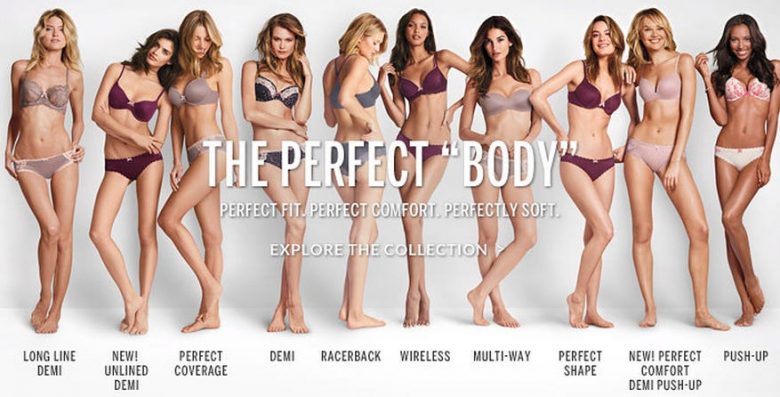
The best solution I have heard to excess product is to give it away in contests and in promotion. There are companies that market and distribute “subscription boxes” themed around high-end categories like makeup, skin-care, collectibles, art supplies, and wine. These services are possible because manufacturers with excess amount give them merchandise.
Alternatively, you destroy the product at a loss to maintain the value of your brand. Make sure that the product is recycled!
Target the upper-middle class.
Contrary to common sense, elites are less conspicuous with their spending than the people of the upper-middle class.
One would imagine that only the elite earners would only consume Veblen goods. The people who have yachts, vacation homes, and garages full of sports cars.
The upper earners are no longer the showiest people among us. In her book The Sum of Small Things, Elizabeth Currid-Halkett makes the case that the elite class is choosing to signal their wealth in less conspicuous ways. They are sending their kids to elite private schools, shopping at organic grocery stores, and publicly discussing articles in The Economist magazine; all of which are subtle, selfless cues that they are rich.
But the biggest consumers of Veblen goods by volume are the people of the upper-middle class, meaning people with a household income of $126,000 – $188,000. These people treat themselves to a taste of luxury they can experience every day, like a Coach purse or a flagship smartphone. If they do travel up the income ladder, it is essential to them to signal that they have “arrived.” They will buy products from the designer labels, like Supreme, that always seemed out of reach.
Conclusion. Price isn’t the hurdle for customers you think it is.
Stop worrying that you are charging too much for your product or service.
Whether you run a Veblen brand or not, you probably think you are charging too much and leaving money on the table because people are walking away when they hear the cost. You don’t like the idea of scaring away customers.
I have worked with plenty of entrepreneurs who will work with anybody at any price. I have never advised an entrepreneur to lower their price. Often I tell them to do a detailed study of their price relative to the market, and they end up increasing their rate!
Savvy brand builders are willing to scare away people who are not part of their customer base. All brands that are worth something say: “we are not for everybody.”
BMB has talked extensively about lifestyle brands, who aim to narrowly serve people with a particular lifestyle like skateboarding or rock climbing. We even have our own project brand: Nordeau.
Charging a reasonable price excludes people who cannot afford it, which is tragic. But it also excludes the people who do not value your brand; the same people who buy something they are not sold on, never use it fully and then tie up customer service with complaints and returns. You need to shed those people off to service your core customers who truly value your product.
If you give up the idea that any sale is a good sale, then you can enjoy a much more hassle-free business and start building a strong brand.
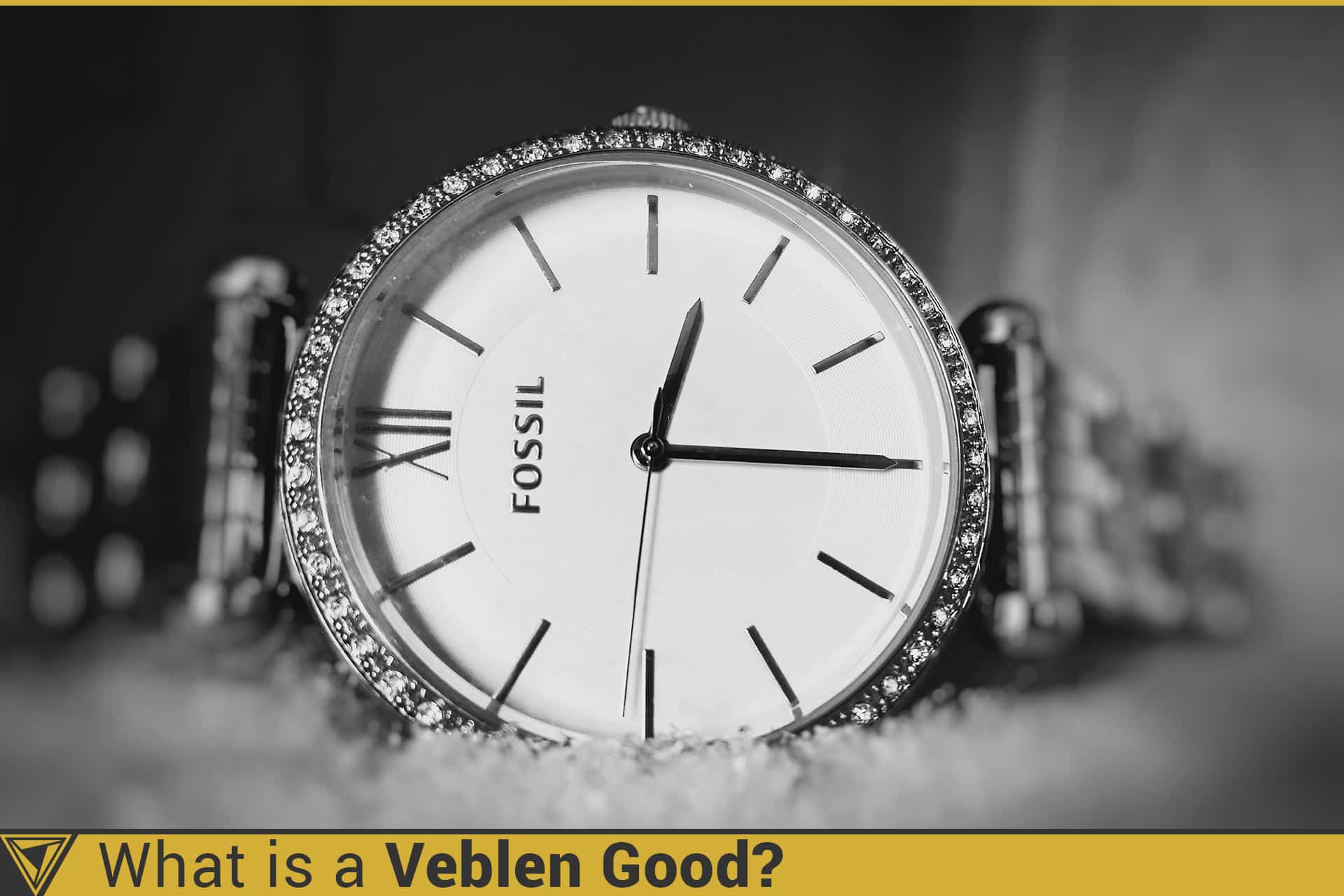
Leave a Reply